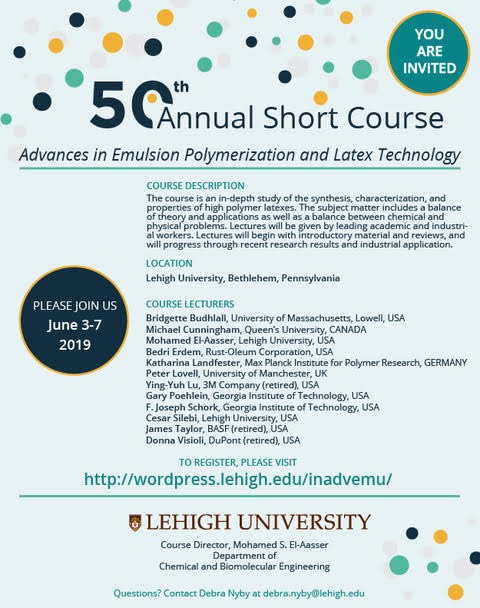The year 2019 marks the 50th anniversary of the continuous, and uninterrupted, offering of the annual short course entitled "Advances in Emulsion Polymerization and Latex Technology", which will be held at Lehigh University on June 3-7, 2019.
The course was first offered in 1970 and organized by Dr. Gary W. Poehlein, a Lehigh professor in the department of chemical engineering. His incentive was purely education. Since neither he nor his PhD student, who had started working on continuous emulsion polymerization process, had any prior experience he decided to reach out and learn from the industrial experts in the field. He invited Wendell V. Smith (Uniroyal), Edward A. Collins (B.F. Goodrich), John L. Gardon (Rohm & Haas) and, John W. Vanderhoff (Dow Chemical) to give lectures. Thirty-five (35) industrial scientists and engineers participated in the 1st course, and the number of course participants increased each year following. When Professor Poehlein left Lehigh to go to Georgia Institute of Technology in 1978 Dr. Mohamed S. El-Aasser, also a Lehigh professor of chemical engineering, took charge of the course starting in 1978 to present day.
Over the past 50 years the course content has expanded to reflect advances in the field of emulsion polymerization and latex technology. Even though the course content changed yearly, a balance was always maintained between the fundamentals, as well as the most recent academic research, and applications. Beside the lectures, evening sessions were added to increase interaction between the course participants and lecturers such as an evening session of Q&A to discuss technical problems facing the industrial participants, an evening poster session with graduate students, and an evening for networking among the participants over pizza and beer.
A total of 112 speakers from the Australia, Canada, France, Germany, the Netherlands, Sweden, UK and USA (representing 34 companies and 25 academic institutions), have given a total of 1,000 lectures. The lectures covered a wide range of topics such as emulsion and miniemulsion polymerization processes and reactor design, kinetics, surfactants and colloidal stability, synthesis and characterization, rheology, latex film formation, latex application topics such as elastomers, coatings, sealant, adhesives, latex-rubber-toughened plastics, asphalt and concrete modifications, and latex for medical applications.
The total number of course participants was 4,000 (3,500 scientists and engineers from industry & 500 graduate students from Lehigh and other universities) also representing numerous countries as well as coming from large, medium and small size companies, including most recently many startup companies. During the first three decades the majority of the participants had more than 5-10 years prior experience in the field, whereas recently more than 75% had less than one year experience.
Below is the 2019 course announcement with lecturers’ names and a link to course web site:
https://wordpress.lehigh.edu/inadvemu/

Final remarks.
Around WWII the US government declared the need of synthetic latex a national priority since the supply of natural rubber from south East Asia was cut off. They ordered companies such as Dow Chemical, and DuPont to direct all their efforts to large scale production of synthetic rubber latex (GR-S) by emulsion polymerization in order to support the war efforts and provide synthetic rubber for automobile and airplane tires, conveyer belts and rubber boots for the soldiers. The US Office of Rubber Reserve of the War Production Board supported interaction between some of the industrial companies and a few US universities to conduct fundamental research; the results were classified as “Secret and Confidential” which were declassified and published several years after the end of the war.
It’s not surprising that the 4 expert speakers at Lehigh’s 1st course in 1970 were all from industry (less than 30 years after the end of WWII). Research in academia flourished over the years and solid interaction between industry and academia led to faster developments and wider areas of application of latexes which are water-based dispersions to replace many of the solvent based applications of different families of polymers. 11 Million Metric tons (~ 22 billion pounds) of synthetic latexes (dry) are consumed in various water-based industrial applications. The forecast for Global demand for emulsion polymers to rise 4.2%/year to 12.5 million metric tons (25 billion pounds) in 2020, valued at $37.2 billion.
Lehigh’s course is considered by many industrial companies as an excellent training of their scientist and engineers over the past 5 decades. We are proud of the university/industry collaboration developed as a result the annual course which also lead to financial support to the emulsion polymers research carried out at Lehigh’s emulsion polymers institute.
Acknowledgement: The success of the course is due to, in addition to the contribution of the 122 lecturers, the excellent efforts of many of Lehigh research scientists and by the office staff, led by Ms. Debra Nyby, the course coordinator for more than 30 years, and the assistance of ~ 250+ of Lehigh graduate (and some undergraduate) students who provided research posters for discussions with the course participants while conducting research in the field of emulsion polymers during their studies at Lehigh to earn their MS and/or PhD’s.
Submitted April 1, 2019 by
Mohamed S El-Aasser
Professor emeritus
Department of Chemical and Biomolecular Engineering
